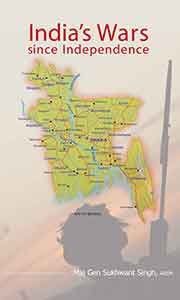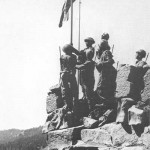The Pakistani enclaves of Fatehpur and Bhago-Kamo lie north-west of Amritsar across the Ravi. Although the area between them is no more than 8,200 by 4,800 metres, they provide sufficient room for crossing the river into Pakistani territory and for expanding this lodgment into a bridgehead for further offensive operations. Two tarmac roads lead from opposite these enclaves to Amritsar, one through Chugawan and the other via Ajnala, with laterals on either side of the Saki Nullah connecting them.
The western lateral from Punga to Lopoke crosses this nullah at Chuchakwal opposite Fatehpur enclave. The nullah, running northeast to southwest parallel to the river, is an anti-tank obstacle, crossable at a few well-established points. Any Pakistani breakout from the enclaves could have outflanked the Indian defences along the Atari drain and overrun the Indian rear areas in a race for Amritsar.
Although it would have been prudent for 15 Infantry Division to include elimination of the enclave of Bhago-Kamo and Fatehpur as part of its plans to improve its defensive posture on the outbreak of hostilities, Bhattacharjea chose to deny the routes of ingress opposite in a defensive posture. 96 Infantry Brigade was accordingly ordered to occupy a defended sector with 15 Maratha occupying a defensive position in the general area of Mudh based on the Saki Nullah with its forward screen along the Dhussi bund skirting the Pakistani enclaves between Chhan-Kalla and Bhindi Aulakh.
The BSF-manned border outposts had been suitably reinforced with Army detachments. The second battalion and brigade headquarters were deployed in the general area of Chugawan, with some elements on the canal at Kohali. The third battalion had gone out of command to be utilized in the Gurdaspur subsector.
Inactivity throughout the day of 5 December had made it amply clear that Pakistan was content with its gains and had no intention of developing deeper thrusts inside Indian territory.
Because of dispersed deployment, 96 Infantry Brigade had no more than a squadron of tanks and one field regiment in support. One of the contingency plans visualised the occupation of Hetampur escarpment in case a threat developed from Ranian. On the night of 3/4 December, Pakistan subjected the BSF posts at Fatehpur, Burj and Ghoga to intense artillery bombardment and followed this up with attacks by elements of 88 Infantry Brigade.
The attack commenced at 2300 hours, and by first light on 4 December Pakistan secured Ghoga, Behlol and Gulgarh, the entire length of the Dhussi bund from Chhan Kalla to Bhindi Aulakh and the post of Fatehpur. Both these villages remained in Indian hands and subsequently functioned as pivots for the recapture of the bund.
BSF personnel falling back were redeployed at Dag and Bhindi Aulakh and reinforced by a platoon each from 15 Maratha, adequately supported by armour and artillery. Inactivity throughout the day of 5 December had made it amply clear that Pakistan was content with its gains and had no intention of developing deeper thrusts inside Indian territory. It was accordingly decided to clear the enemy along the Dhussi bund from Tur, Burj, Vera up to Fatehpur-Chhan Kalla. On 5 December, 150 men of 5 East Bengal Rifles walked over to the Indian troops in voluntary surrender at Dag and Bhindi Aulakh and furnished useful information.
Emboldened by the easy successes earlier, Pakistan attacked Bhindi Aulakh at midday on 6 December from the direction of Tur with a company later identified as belonging to 43 Baluch. The enemy assaulted in the open without armour support. This folly of a daylight attack in plain country was fully exploited by the Indians, who inflicted heavy casualties on the attackers. The attack having petered out, the officer commanding 15 Maratha went on the counter-offensive immediately to capture Tur and Burj.
The plan was simple and involved a troop of armour working from east of Tur while a company of 15 Maratha with elements of BSF worked along either side of the Dhussi bund from the direction of Bhindi Aulakh. Progress along the bund was slow, involving hand-to-hand fighting from bunker to bunker, and resulted in casualties, including the company commander. The was however afternoon, when the bund troop of armour was ordered to cross it and tackle Burj from the rear.
From an analysis of casualties and equipment captured, it appeared that the opposition encountered in the entire operation of Chhan Kalla-Fatehpur-Bhindi Aulakh was no more than two infantry companies without tanks.
The timely induction of a second company from the depth position on the Saki Nullah kept up the momentum of the attack. This company and the armour were able to carry Burj with minimal fighting as 43 Baluch, holding the bund, saw the armour in its rear and reeled back across the Ravi. The bund from Bhindi Aulakh to Burj was secured by last light on 6 December. In this action our assaulting troops captured 11 BMGs, 17 rifles, eight stens, two RLs, one RCL, signal equipment and large quantities of ammunition. The enemy left 52 dead. It appeared that at least two companies of 43 Baluch were badly mauled.
Because our troops were inadequate for an assault, the gains of the Dhussi bund up to Burj were consolidated and efforts made to extend towards Burj. A section patrol was established to overlook it from the bund. The stalemate continued up to 9 December, when shortly after midday a platoon worth of Pakistani troops suddenly emerged from the tall sarkanda grass and threw back the section patrol. A company then advanced and established complete control of the bund up to Burj. It was able to harass our defences with accurate small arms fire and shelling.
15 Maratha immediately counter-attacked from Burj towards Vera and managed to capture it by 1445 hours. The post was immediately reinforced. Soon after Pakistan attacked it from the Fatehpur side, but was beaten back by artillery and tank fire with telling effect. Undaunted, the Pakistanis launched another attack from the new Dhussi bund, but this was also repulsed with considerable damage to the assaulting forces.
It is significant that the successive Pakistani counter-attacks were not supported by armour. These were purely daylight assaults by infantry in open country, which time and again proved disastrous. The situation however stabilized by last light, and the enemy left large quantities of ammunition, three BMGs, two RLs and one jeep and about 32 dead. 15 Maratha suffered about 30 casualties. The positions at Vera and Burj were subsequently reinforced by the remainder of the battalion, now lifted from the depth-defended locality on the Saki Nullah. It was felt that 43 Baluh had been considerably mauled in these operations from 3 to 9 December.
By now it was abundantly clear that Pakistan had no intention of using these enclaves for a push towards Amritsar and was only resorting to futile local operations. As such, there was no longer any need for depth defences in the general area of Chugawan-Kohali. It was therefore decided to capture Fatehpur by lifting 8 Sikh Light Infantry from the depth area. Available information indicated that the enemy was holding the diamond formed by the bund system in the area of Fatehpur with about two companies plus, adequately backed by elements of the reconnaissance and support battalion.
The battalion attack was to be carried out in three phases. The first phase involved the capture of the Dhussi bund up to the Pakistani post at Fatehpur by two companies, the second the capture of the bund junction by one company, and the final phase the capture of the area known as Twin Huts by one company. The direction of attack was planned along the bund from Vera, which was held by 15 Maratha and provided a firm base for this action. A squadron of tanks was to support the assaulting troops with fire in the first phase while some commando groups were to intercept Pakistani reinforcements from the new Dhussi bund.
By now it was abundantly clear that Pakistan had no intention of using these enclaves for a push towards Amritsar and was only resorting to futile local operations.
The assault got going as planned, with small groups operating from bunker to bunker on both sides of the bund supported by tank fire. The assault progressed slowly but steadily, and Fatehpur was secured by midnight on 11/12 December. The subsequent phase was then launched, and the assaulting companies captured the bund junction by approximately 0200 hours against slight opposition. But they were soon subjected to counter-attack twice.
The company commander was fatally wounded when he called for defensive fire on our position. By first light on 12 December, the whole position was heavily shelled by Pakistani artillery and the battalion suffered more casualties. Despite everything, the entire diamond was secured, and the area of Twin Huts was cleared later. The casualties inflicted on the enemy in this operation were 32 killed and nine captured against India’s 101 wounded and 36 killed. The equipment captured consited of ten MMGs, 11 rifles, five stens, one 106-mm RCL and plans were prepared for an attack by 15 Maratha on Bhago-Kamo, but that did not materialize because the ceasefire internened.
From an analysis of casualties and equipment captured, it appeared that the opposition encountered in the entire operation of Chhan Kalla-Fatehpur-Bhindi Aulakh was no more than two infantry companies without tanks. These were probably forward elements of the formation holding the defended area across the Ravi.
The tactical importance of these enclaves lay in their potential for establishing a bridgehead for a thrust towards Amritsar or Atari, depending upon the strategic aim of the operations.
To obviate this advantage of secure crossings to Pakistan in its own territory, it would have been better to eliminate these enclaves at the very outset. And the best way to tackle them would have been from the rear along the river, as was done n respect of Dera Baba Nanak, rather than embarking upon costly assaults along the bund line.
The availability of armouor for the operation against the naked Pakistan infantry should have been fully exploited.






1 India-trained Mukti Bahini HERO = 10 DARPUK-Coward, Surrendered Foj.